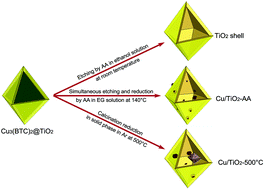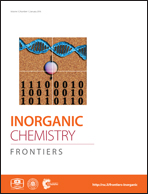Cu/TiO2 octahedral-shell photocatalysts derived from metal–organic framework@semiconductor hybrid structures†
Abstract
The insertion of metal cocatalysts into semiconductor photocatalysts, which can promote electron–hole separation and provide additional reaction sites, is a popularly used approach to improve photocatalytic efficiency. In this article, we demonstrate a facile synthetic method for Cu/TiO2 photocatalysts with hollow structures by templating on metal–organic frameworks (MOFs). The Cu3(BTC)2 MOF octahedral microcrystals enwrapped by TiO2 shells serve as a Cu precursor for the in situ generation of Cu nanoparticles on the TiO2 photocatalyst. This method offers the versatility to tailor the photocatalyst configurations (including compositions, crystal phases, cocatalyst sizes, etc.) by simply altering the treatment conditions on MOF cores (e.g., room-temperature etching, simultaneous etching and reduction, and high-temperature calcination reduction). Enabled by the varied configurations, the synthesized octahedral-shell photocatalysts exhibit remarkably different performances in charge separation and photocatalytic hydrogen production, allowing the identification of an optimal design for photocatalysis.

- This article is part of the themed collection: 2015 Emerging Investigators by ICF

 Please wait while we load your content...
Please wait while we load your content...